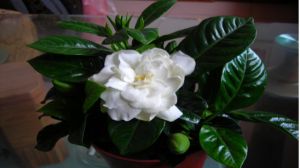How did the hanging orchid burst the basin?

1. The flowerpot is suitable
If you want its roots to be better stretched, you can choose a larger tile basin, because the basin made of this material is extremely good in terms of air permeability and drainage, so it is of great benefit to the growth of the orchid.
2. The soil is fertile
Soil also plays a key role in whether it bursts or not. Usually the fertile soil is most suitable for its growth, here we can make it with a mixture of rotten leaf soil and cinder, and then add a little organic fertilizer to it to facilitate its growth.
3. Appropriate watering
When watering it, you can't water it too much each time, but the frequency should be more frequent, because it likes water very much, and it is best to water it every 3 days normally, but in summer, the weather is muggy and the water evaporates quickly, so we can water it three times a day; then in winter, it will enter a dormant period, then stop watering, wait for the soil to dry, and then water it a little more.
4. Fertilizing frequently
It needs a lot of nutrients, so you should often fertilize it every 20 days when raising it, and then when it comes to winter dormancy, it absorbs limited nutrients, so there is no need to apply fertilizer at this time.
5. Sufficient light
When it grows, it needs enough sunlight, if the light is not enough, it will make its leaves yellow, and it is not good for its growth. So put it in a place with plenty of light, but you can't be exposed to strong light.
6. Ambient temperature
When raising it, you need to find an ambient temperature suitable for its growth, which is the best between 15 and 25 degrees, and the temperature can not be lower than 5 degrees or higher than 38 degrees, so it is best to move it indoors in winter and control the temperature above 12 degrees. This is the only way to get it through the winter.
- Prev

How to trim the roots of Fugui bamboo
When cutting the root, cut it slightly with an oblique opening in the appropriate position to increase the contact surface with water, so that it can absorb nutrients and water more fully. When pruning the roots, trim off the rotten, injured, poorly grown and old roots. After pruning, we should pay attention to the timely replacement of clear water, be careful not to hurt the new roots.
- Next

How to raise gardenia in autumn
Lighting: sometimes the light is so strong in autumn that it needs shade and leaves 60% of the illuminance. Humidity: need to guarantee about 70%. Fertilizer: can use bean cake and other fertilizers, pay attention to the comprehensive nutrition. Temperature: preferably eighteen to twenty-two degrees. Pruning: after the flower fades, it should be trimmed. In addition, we should also pay attention to prevent some diseases.
Related
- What if the leaves of potted flowers turn yellow?
- Florescence Control of several Flowers
- Anti-freezing technology and post-freezing nursing technology of flowers
- What is the classification of flowers? What are the common methods of flower classification?
- Prevention and control of alkali and acid damage of flowers in courtyard
- Technology of Anti-freezing and restoring growth of Flower seedlings in greenhouse and greenhouse
- How does flower fertilization not hurt the root? Fertilization technology of flowers
- Key points of disinfection in flower greenhouse
- Several pesticides that are banned or used cautiously in flowers
- How to fertilize the flowers that watch the leaves?

